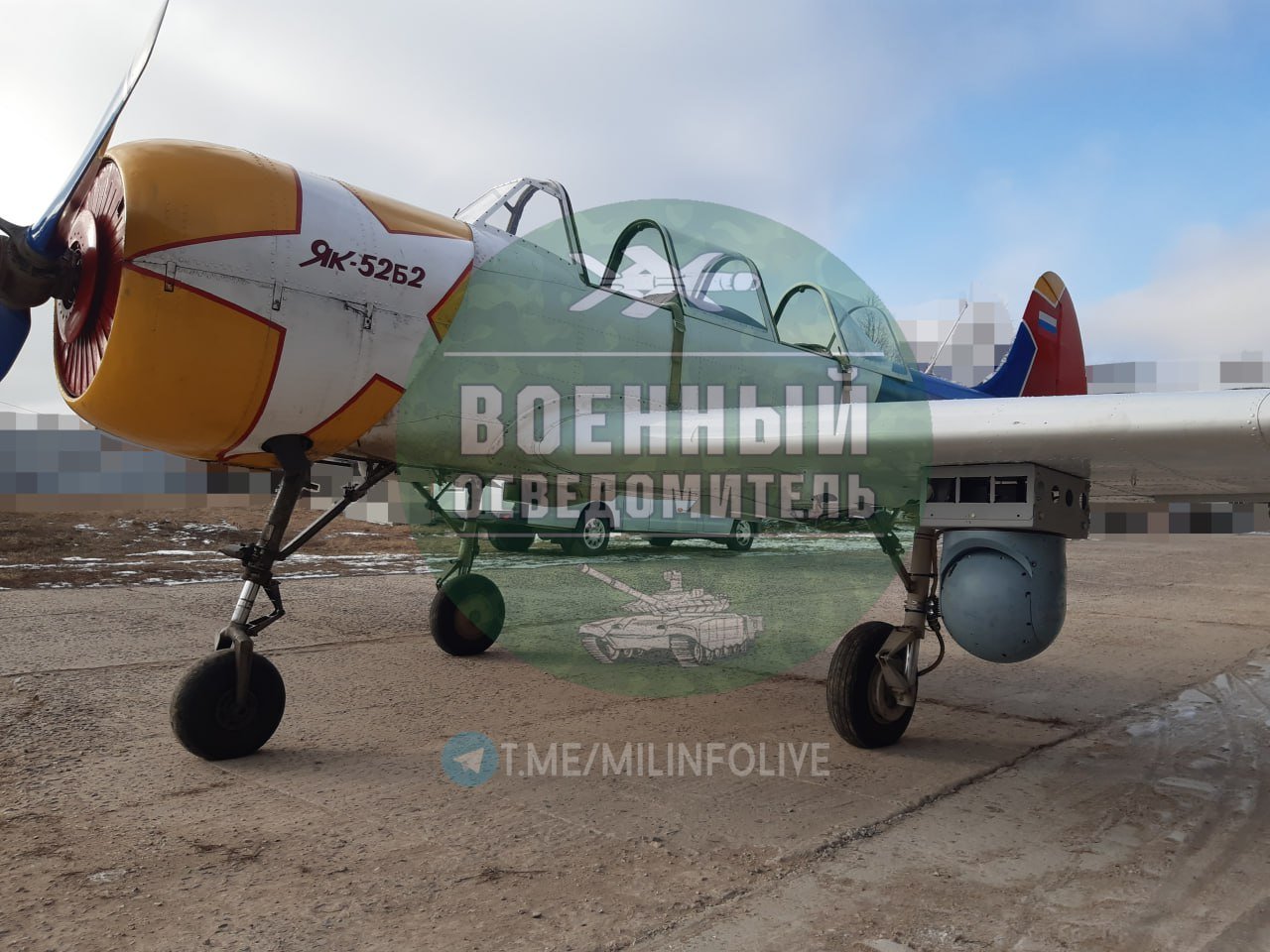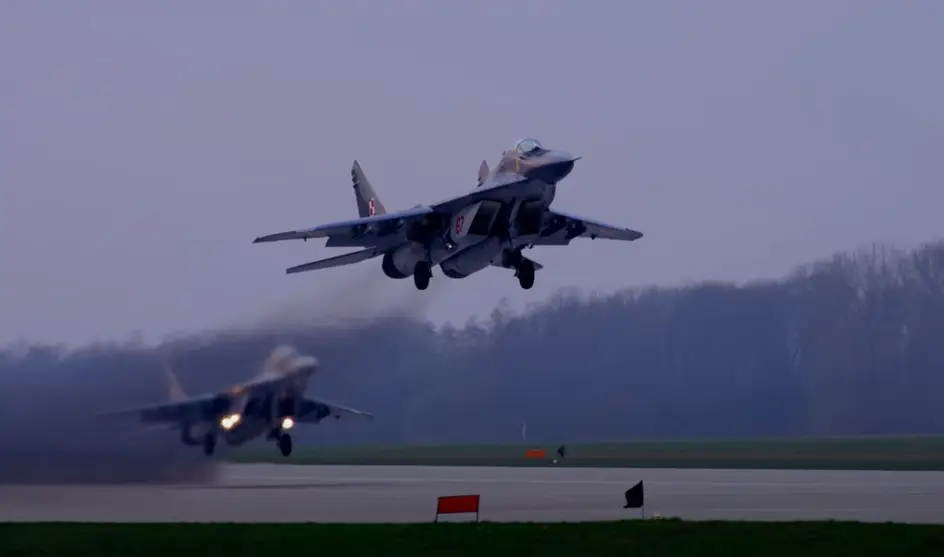
New Russian fighter jet and micro kamikaze drones
Russia, May 19, 2025 – If the destruction of teams of drone operators is currently becoming the preferred tactic, then the murder of developers of drone design bureaus, radio-electronic warfare and other technologies necessary for drone warfare, deep behind enemy lines, has apparently also become an acceptable strategy
Currently, there is talk of a group attack by six Russian kamikaze drones controlled by artificial intelligence, which identified each other using machine vision of the different color of their wings and attacked all at once. For Russia, attacks by Ukrainian attack drones deep inside its own territory have become a problem and it has pulled out of mothballs a project from the times of the war in Afghanistan, which it is gradually and rather cumbersomely adapting to new circumstances.
One of the Russian experimental design bureaus specializing in aircraft production has carried out a deep modernization of the Yak-52 trainer aircraft into the Yak-52B2 modification – an anti-drone fighter. The modernization was based on the experience of creating a light combat/COIN (Counter-insurgency) Yak-52B aircraft from the times of the Afghan war in the 1980s.
According to the development company, when choosing an aircraft type for these tasks, the initial performance characteristics of the aircraft were taken into account, which significantly exceed the characteristics of such aircraft as the Cessna-172 and Yak-18T, with which they were experimented earlier. In addition, the existing fleet of Yak-52 aircraft allows for the mass expansion of this project.
Thanks to the modifications, the aircraft can carry a payload of 90 kg under each wing. The payload was allegedly an all-round scanning radar operating in air-to-air, air-to-ground and meteorological radar modes, or the PERGAM S400 electro-optical sensor. A 12-gauge semi-automatic shotgun is currently used as a means of destruction.

The aircraft is equipped with an on-board computer, which, among other things, generates targeting information, and a modern flight and navigation system, which allows it to fly day and night, in both simple and difficult weather conditions.

With these modifications, the light Yak-52B2 with a piston engine is capable of attacking enemy unmanned aerial vehicles such as the An-196 “Lyuty”, as well as light aircraft in an unmanned version, such as the Aeroprakt A-22. Currently, the aircraft has a certificate of airworthiness and is undergoing tests to debug its on-board equipment. It should be added that the Yak-52B2 represents an advance over the Ukrainian attempt to deploy a regular training and sports Yak-52 in daytime conditions with an open cockpit, from which a crew member shoots at drones with a regular shotgun.
The question remains how the shotgun also got into the Russian modification, or rather whether the former USSR thought ahead enough and tested a more effective alternative. The answer that one would expect more from Brussels is regulation, a requirement of the law. The shotgun was originally designed with the aim of having a civilian aircraft with civilian weapons within the framework of the implementation of the laws “On Private Detective and Security Activities in the Russian Federation” and “On the Safety of Fuel and Energy Complex Facilities”, in which amendments were made regarding the activities of private security companies against unmanned aerial vehicles when guarding protected facilities.
The licensing and permitting authorities of the Russian National Guard did not support the idea of using aviation to protect critical infrastructure facilities – they considered it too complicated. The installation of PKTM had to be abandoned due to the high probability of causing damage to third parties on the ground. At the moment, the decision to arm the Yak-52B2 with a shotgun is forced and temporary – it is not yet final.
Russia is trying to increase passive protection, especially of oil and gas industry facilities, from drone attacks, which have become less frequent, probably due to political decisions. This may change if even a special military operation eventually transforms into a war. The question remains whether it is possible to shoot down a kamikaze drone built on the platform of a light sport aircraft with a shotgun, which, of course, will also fall to the ground in such a case and endanger third parties.
However, the Russians themselves have developed kamikaze drones, for which the Yak-52B2 could theoretically be sufficient. However, currently, it is being presented as a tank destroyer, the new kamikaze drone Тювик (Tjuvik – hawk), allegedly intended for operations on the line of combat contact (for which the gasoline version apparently necessarily needs a range of 100 km).

Russian troops on the Ukrainian battlefield will soon be armed with new attack unmanned aircraft Tjuvik, which are similar in appearance to the Geraň kamikaze drones. This was reported by the management of the KB Stratim design bureau. Stratim specialists have created a practically miniature version of the Geraň kamikaze drone, which they called Tjuvik. The new drone is designed for operations directly on the front line, its main task is to destroy enemy armored vehicles, if necessary, it can also operate against bunkers and infantry. The “Tjuvik” drone has already passed tests in the SVO zone and has entered the stage of serial production. It will soon arrive in the troops.
“Tjuvik” is manufactured according to the design scheme of a flying wing, essentially copying the contours of the Geraň drones. It launches in a similar way from stands. The drone’s unique feature is that it can counteract the operation of electronic warfare systems thanks to the use of the stable “Pozemka” communication system developed for Tjuvik. The Izvestia newspaper quotes the founder of KB Stratim, with the nom de guerre Obi-Wan:
“This light attack wing is designed to destroy armored vehicles.”
According to information from the KB Stratim website, Tjuvik was developed in two versions: with an electric and gasoline engine. The electric version has a speed of 150-180 km/h, a range of 40 km, a payload of 3 kg, a flight time of 20 minutes. The gasoline engine has a speed of 300-350 km/h, a range of 100 km and a payload of 4 kg.
What can we note here in conclusion, in addition to the growing dominance of drones on the Ukrainian battlefield. Russian regulations on civilian possession of weapons, including their use by security services, have failed to adapt to current realities after the experience with organized crime in the 1990s. On the other hand, according to available information, the release of landed black dolphins into the wild is not being considered. And the regulations give rise to weapons that are absurd from an external point of view, for example, a version of the Dragunov sniper rifle chambered for the 9.6×53 mm Lancaster cartridge.
At least Russia is starting to cover up the developers of the technologies needed for drone warfare, who no longer even use civilian names for the sake of short-term worldly fame, so as not to smell the grass from below.


Martin Scholz


















